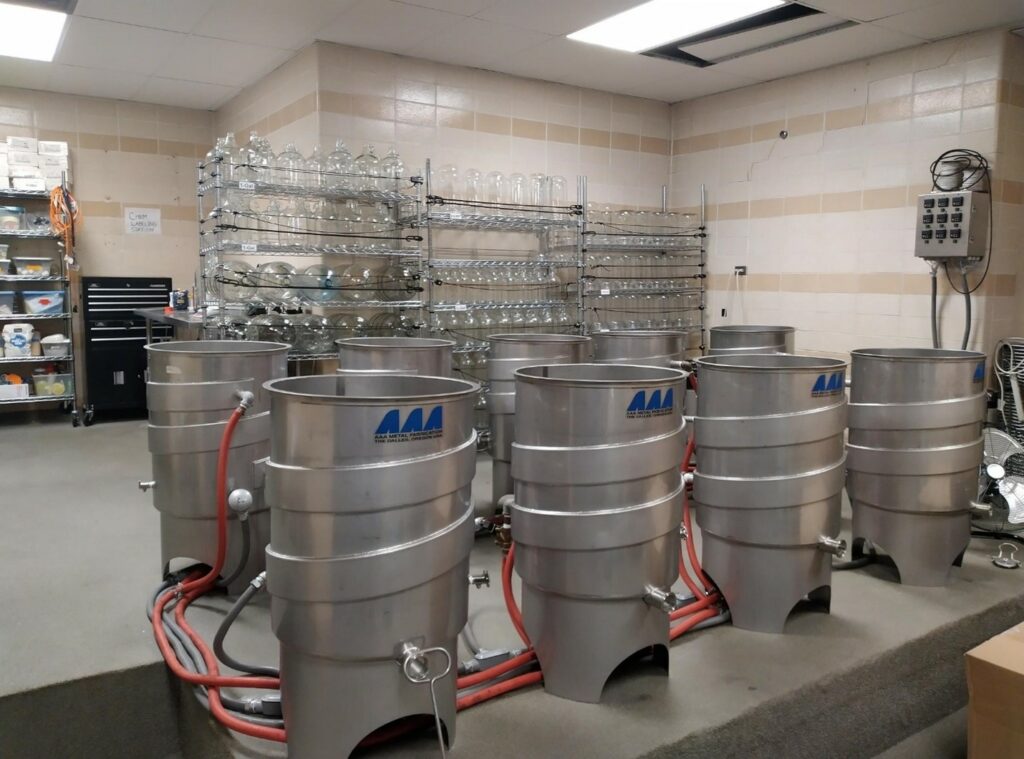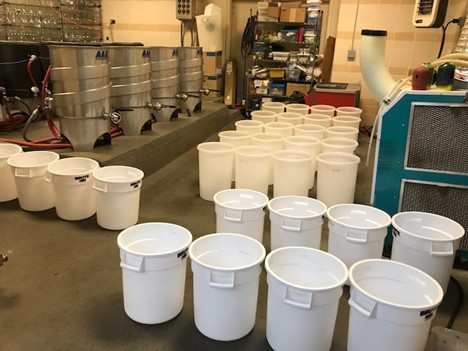Dr. James Osborne, Associate Professor & Extension Enologist
One ongoing concern during winemaking is the formation of volatile sulfur compounds (VSCs) that may negatively impact wine aroma. These compounds are either produced during primary fermentation or during wine aging. The most common of the VSCs produced during wine production is hydrogen sulfide (H2S) which imparts a distinctive “rotten egg” character to the wine and is a product of yeast sulfur metabolism (Rauhut 1993). Hydrogen sulfide may be produced by Saccharomyces cerevisiae during fermentation by a number of mechanisms including degradation of sulfur containing amino acids as nitrogen sources, reduction of elemental sulfur used as an antifungal treatment on grapes, and/or reduction of sulfate or sulfite present in the juice (Guidici and Kunkee 1994, Moreira et al. 2002). Due to the potential negative impact of H2S on wine quality and the fact that H2S formation occurs relatively frequently, a number of research studies have focused on understanding the formation of H2S and ways to prevent its formation. Many of the major factors influencing H2S formation are better understood thanks to these studies. Grape nutrient deficiencies and yeast strain are two of the dominant influences (Rauhut 1993, Spiropoulos et al. 2000).
While H2S formation occurs mainly during primary fermentation, additional VSCs can be formed at later stages during winemaking. The formation of these compounds can be difficult to predict, and their formation is not necessarily related to H2S issues during the primary fermentation. This may mean that even though sulfur off-odors were not noticed during primary fermentation, there may still be problems with sulfur compounds during barrel aging. The VSCs involved include mercaptans and disulfides that have distinctive aromas such as skunky, rubbery, garlic, onion, or cabbage-like. Often the problems occur soon after wine is placed in barrel. Some of this is triggered by the wine environment becoming increasingly reductive as it ages, particularly at the bottom of the barrel and in the wine lees. In addition, problems with sulfur off-odors may be more prevalent in one year versus another or in grapes from one vineyard block but not the adjacent block, despite identical vineyard management practices. Many factors contributing to this problem are not well understood and make developing strategies to prevent VSC formation difficult.
To understand this further, my laboratory began collaborating with Dr. Michael Qian’s flavor chemistry lab to conduct a research project investigating factors impacting VSC formation during post-fermentation. Our initial goal is to understand the link between grape composition, wine lees composition, and the development of VSC during aging. It is currently known that these sulfur off-odors often arise from degradation of sulfur-containing compounds in the yeast lees or from the re-release of chemically-bound sulfide during aging (Rauhut 1993, Moreira et al. 2002). For this reason, lees management may play a role in minimizing the formation of sulfur off-odors. In particular, wine should be removed from heavy lees as early as possible. Heavy lees are defined as those that precipitate within 24 to 48 hours after the completion of the primary fermentation. Wines should be separated from these lees as they can promote the production of sulfides and mercaptans. It is advised that you smell and taste your wine and lees frequently as sulfur off-odors may occur rapidly, and this will allow you to take quick action. Be sure to obtain a sample of your lees from the bottom of the barrel and monitor for the formation of sulfur off-odors. The lees may sometimes smell bad but the wine is not yet affected. The earlier the detection, the greater ability you have to take appropriate action to minimize further damage.
You may be wondering about the appropriate actions to treat sulfur-off odors in your wine. Well, while large amounts of H2S may be produced during fermentation, much of this H2S is usually volatilized from the wine along with CO2 during active fermentation. However, residual H2S can pose a problem due to its low sensory threshold and its potential reactivity. In particular, the formation of mercaptans and disulfides during cellar aging can be very problematic as these compounds are more difficult to remove. After fermentation, when H2S alone is present, aeration and splashing may dissipate the odor. If H2S aromas persist, then it may be necessary to treat the wine with copper sulfate. Treatment of wines with copper sulfate is a common practice used to remove H2S and mercaptans. Copper ions combine with H2S and mercaptans to form complexes with no offensive smell. After treatment with copper, the wine can then be racked off the lees. Copper sulfate is normally added to the wine, but bench top trials MUST be conducted to determine the appropriate dose. Results from lab-scale trials do not always transfer directly to larger volumes of wine, so you will need to reevaluate the wines after treatment and before conducting further cellar activities. Keep in mind that reactions may take longer to occur in the cellar than in the lab set-up, so allow extra time before determining whether sufficient copper has been added or whether additional additions should be made. Concentrations of between 0.05 and 0.3 mg/L of copper are commonly added. It is important to be careful with the amount of copper added to your wine, as TTB regulations allows additions of up to 6.0mg/L copper and residual levels of no more than 0.5mg/L. Copper should not be added to the wine until the fermentation is complete and the amount of yeast material is reduced by racking. Yeast cells can bind with copper and reduce effectiveness. Also, addition of copper during fermentation may promote H2S production by yeast.
The formation of disulfides during wine aging can be more problematic, mainly because they are more difficult to remove. They will not be removed by copper. If you aerate wine to remove sulfide aromas, you may oxidize mercaptans present to disulfides. Initially, you will notice a loss of the offensive mercaptan aromas as disulfides have a much higher sensory threshold than mercaptans and may not be detected even with the disulfides still present. When conditions in the wine become more reductive (during barrel aging or in the bottle) the disulfides can be reduced back to mercaptans resulting in a reappearance of sulfide aromas. Sulfide aromas may also reappear even after a copper treatment initially seemed to remove them; this is due to the presence of disulfides that were not removed by copper being reduced back to mercaptans. Since disulfides are difficult to remove from wine, the best approach is taking early preventative measures to minimize the production of H2S during fermentation and the formation of mercaptans. These measures include providing sufficient yeast nutrients for a healthy fermentation, using low H2S producing yeast strains, early removal of wine from heavy lees, and monitoring wine lees for sulfur off-odors during barrel aging. These strategies will help minimize the formation of the more troublesome mercaptans and disulfides.
Literature Cited
Giudici, P. and R.E. Kunkee. 1994. The effect of nitrogen deficiency and sulfur-containing amino acids on the reduction of sulfate to hydrogen sulfide by wine yeasts. Am. J. Enol. Vitic. 45:107-12.
Moreira, N., F. Mendes, O. Pereira, P. Guedes de Pinho, T. Hogg, and I. Vasconcelos. 2002. Volatile sulphur compounds in wine related to yeast metabolism and nitrogen composition of grape musts. Anal. Chim. Acta 458:157-167.
Rauhut, D. 1993. “Yeasts – production of sulfur compounds” in Wine Microbiology and Biotechnology, ed. G.H Fleet. Harwood Academic Publishers, Switzerland. 183-223.
Spiropoulos, A., J. Tanaka, I. Flerianos, and L.F. Bisson. 2000. Characterization of hydrogen sulfide formation in commercial and natural wine isolates of Saccharomyces. Am. J. Enol. Vitic. 51:233-248.








